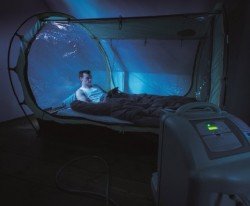
Height training is a well-known training method. In the past, athletes had to rely on internships in the mountains, nowadays it is also possible to train and / or live at simulated heights. There are new, promising developments in this area concerning intensive and short-term training protocols. These developments are listed in this article.
Altitude training and internships are often associated with endurance sports such as running, cycling and skating to improve 1) the performance at altitude and 2) the performance at sea level. However, more and more forms of altitude or hypoxic (low oxygen) training are appearing that (also) focus on team sports and / or sports with a large anaerobic component.
LHTH and LHTL
The classic training course, which involves spending a period of time at altitude and training there, is also known as Live High Train High (LHTH). A disadvantage of this form of altitude training is that the athlete cannot deliver the same power as training at sea level due to the reduced oxygen content in the air. As a result, the absolute intensity during this type of training decreases by about 7% per 1000m ascent. To counteract this decrease in absolute intensity, a new method of altitude training was developed in the early 1990s. This involves training at a lower altitude than the altitude at which the athletes spend the rest of the day. This way, the intensity of the training can be guaranteed, while the body still receives a hypoxic stimulus. This new method of altitude training is called Live High Train Low (LHTL) and the positive effects have been confirmed several times in follow-up studies. In practice, LHTH and LHTL are often combined into Live High Train High&Low (LHTHL) whenever possible, with only the more intensive training being carried out at a lower altitude and the calmer training being carried out at the residential altitude. In a recent study of altitude training, the best results on swimmers' performance were found with four weeks of LHTHL compared to three and four weeks of LHTH and four weeks of living and training at sea level. Whether LHTHL is also more effective than LHTL is not clear from this study, but it is a lot more practical. Modern variants of LHTL are:
- staying at simulated heights (normobarable hypoxia) in heights and
- apartments (and training in normal outdoor air);
- staying at height and training with extra oxygen, which is administered via a mask;
- Live Low Train High (LLTH), where you expose yourself for a short time to oxygen-poor air that simulates a high altitude. With this last form of altitude training (LLTH) a distinction can be made between:
- Intermittent Hypoxic Exposure (IHE): exposure to hypoxia, often by inhaling hypoxic air through a mask6, without exercising/exercising; - Intermittent Hypoxic Training (IHT): the athlete trains for a few hours a day for one to four weeks at simulated altitude, for example in a hypoxic chamber.
IHT comes in many variants, from all-out efforts of less than 30 seconds to two hours of training at 60-70% of the heart rate reserve. The interest in IHT lies in the fact that it is a special way of training and you don't have to go to the mountains for it, which saves both money and time. Below we will first discuss the physiological adjustments for (traditional) altitude training. Subsequently, new literature regarding different LLTH training courses will be discussed. The question of why some athletes respond less to altitude training than others will also be discussed.
Read the full article by Sam Ballak, Susan Bol & Albert Smit here
